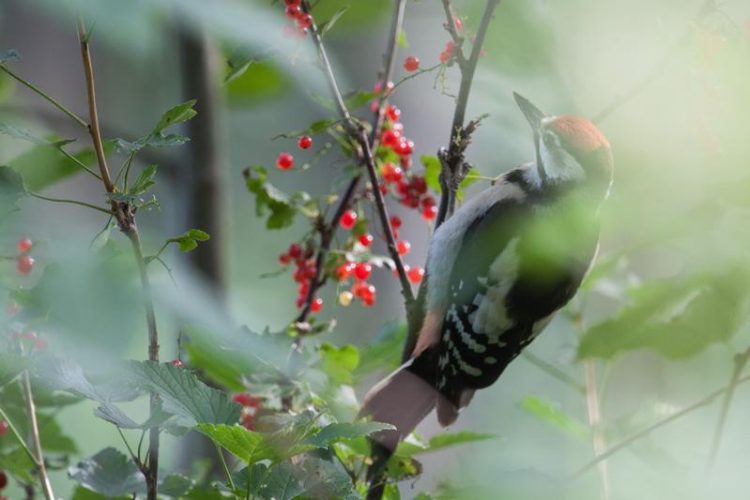Fatal connection

A woodpecker is feeding on the fruit of the Red currant (Ribes spicatum). By defecating the plant seeds elsewhere, the bird contributes to their dispersal. (Photo: University of Marburg / Jörg Albrecht)
“Many plants rely on pollination of their flowers by insects and also need birds or mammals that disperse the plant seeds”, first author Jörg Albrecht explains. “In this case, pollinators and seed dispersers indirectly benefit each other because they increase the reproductive success and dispersal capacity of the shared food plants.”
So far, most studies focus exclusively on a single type of interaction: e.g., on the relationship between predator and prey, or on the interaction of plants with their pollinators. But, as the authors point out, “the same species are often involved in multiple processes.”
Scientists led by Associate Professor Dr. Nina Farwig and Professor Dr. Roland Brandl of the University of Marburg wanted to know whether the destruction of habitats acts in the same way on multiple interaction networks.
The researchers found strong evidence for coupled responses of pollinators and seed dispersers to logging: “Our findings signal an alarm,” the authors write, “as they predict that the conversion of primary old-growth forest ecosystems to secondary habitats may involve a parallel loss of multiple animal-mediated ecosystem services.”
Dr. Nina Farwig holds the Robert Bosch Junior Professorship for “Sustainable Use of Natural Resources” at the University of Marburg. The current study was part of the doctoral thesis of Jörg Albrecht in the “Conservation Ecology” group under the supervision of Nina Farwig.
The project was funded as part of a doctoral fellowship from the German Federal Environmental Foundation to Jörg Albrecht and by funds from the Robert Bosch Foundation to Nina Farwig. Co-author Professor Dr. Roland Brandl is head of the “Department of Ecology – Animal ecology” group at the University of Marburg.
Original publication: Jörg Albrecht & al.: Correlated loss of ecosystem services in coupled mutualistic networks, Nature Communications, 2014, DOI: 10.1038/ncomms4810
For more information:
Contact:
Jörg Albrecht, MSc.
Arbeitsgruppe Naturschutzökologie
Tel.: 06421 28-25385
E-Mail: joerg.albrecht@staff.uni-marburg.de
Juniorprofessorin Dr. Nina Farwig,
Arbeitsgruppe Naturschutzökologie
Tel.: 06421 28-23478
E-Mail: farwig@staff.uni-marburg.de
Homepage: http://www.uni-marburg.de/fb17/fachgebiete/oekologie/conserv_ecol
Media Contact
All latest news from the category: Life Sciences and Chemistry
Articles and reports from the Life Sciences and chemistry area deal with applied and basic research into modern biology, chemistry and human medicine.
Valuable information can be found on a range of life sciences fields including bacteriology, biochemistry, bionics, bioinformatics, biophysics, biotechnology, genetics, geobotany, human biology, marine biology, microbiology, molecular biology, cellular biology, zoology, bioinorganic chemistry, microchemistry and environmental chemistry.
Newest articles

A universal framework for spatial biology
SpatialData is a freely accessible tool to unify and integrate data from different omics technologies accounting for spatial information, which can provide holistic insights into health and disease. Biological processes…

How complex biological processes arise
A $20 million grant from the U.S. National Science Foundation (NSF) will support the establishment and operation of the National Synthesis Center for Emergence in the Molecular and Cellular Sciences (NCEMS) at…

Airborne single-photon lidar system achieves high-resolution 3D imaging
Compact, low-power system opens doors for photon-efficient drone and satellite-based environmental monitoring and mapping. Researchers have developed a compact and lightweight single-photon airborne lidar system that can acquire high-resolution 3D…





















